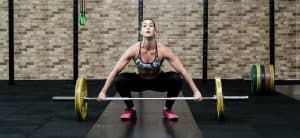What is the EDT technique?

EDT is Escalating Density Training. It’s a hypertrophy training technique (think big muscles). The goal is to perform as many reps as possible in a given timeframe, using antagonistic exercises, which work opposing muscle groups.
- Choose two antagonistic exercises – such as a pull and a press movement. Front squat and hamstring curl are one example, or bicep curls and tricep press.
- Choose a weight that is your 10RM (10 Rep Max) for the exercises.
- Start a stopwatch or timer for 15 minutes.
- Perform 5 reps of each movement, in an alternating fashion
- Rest as long as needed and repeat, letting the number of reps drop as you fatigue (sets of 4, then 3, etc.)
- The goal is to perform as many reps (of both exercises) as possible in the 15 minutes. When finished write down the total number of reps, so you can beat that number next time. The 15 minute time period is referred to as a Personal Record Zone or PR Zone.
What sort of exercise should I use with EDT?
EDT is supposed to utilize antagonistic exercises – a push and a pull for example. Why? Because due to reciprocal innervation you’ll be able to perform more total work. The opposing muscles of the second exercise will “refresh” the fatigued muscles and nervous system involved in the first exercise. Think of the exercises commonly used in “super-sets”.

This is primarily a hypertrophy method – so you’d use dumbbell, barbell, or body-weight exercises for building strength and muscle size. It can also be used to build strength (but not in an optimal fashion, in our opinion), and gives a fat burning effect by virtue of the pace and total number of reps being performed.
 –
Charles Staley, a world renowned strength coach, invented the Escalating Density Training (EDT) concept in 2002. To find out more in detail about the EDT philosophy grab a copy of the book he wrote titled Muscle Logic (Buy on Amazon). Besides being the definitive description of EDT, it’s also got general advice on strength and muscle building basics, and exercise descriptions.
–
Charles Staley, a world renowned strength coach, invented the Escalating Density Training (EDT) concept in 2002. To find out more in detail about the EDT philosophy grab a copy of the book he wrote titled Muscle Logic (Buy on Amazon). Besides being the definitive description of EDT, it’s also got general advice on strength and muscle building basics, and exercise descriptions.
How does the EDT technique work?
EDT implements the magic formula for hypertrophy, or training muscles to be big rather than just strong. You can accumulate a lot of volume with medium weights and with short rest periods – that’s the magic formula.
Secondly, you can base your entire workout around this method, by utilizing multiple PR Zones, such as one for upper body and one for lower body.
What equipment do I need for the EDT technique?

The essential gear is a clock, stopwatch, or timer.
The FitAtMidlife free workout timer is a great choice for EDT workouts. Simply set the round length setting to 15 minutes and the rest length to 0 secs, then click Start.
Precision timing isn’t a requirement with this technique so a watch, smartphone, or wall clock will work just as well.
Secondly, you’ll need whatever equipment your choice of exercise requires such as dumbbells, barbells, etc.
EDT Workout Ideas
Need some ideas for an EDT workout? Here’s a few you can try.
- Pushups/Pullups (or Chin Ups)
- Bicep Curls/Tricep Press
- Bench Press/Rows
- Back Squat/Chins
- Front Squat/Dips
- Deadlift/Floor Press
- Overhead Squat/Clean Pull
- Muscle-Up/Power Clean
- Front Squats/Glute Ham Raises (GHR)

Why choose the EDT technique?
As we’ve mentioned, this is a method for growing muscles bigger. It’s also fun – because it’s a challenge, and it’s easily measurable. Secondly, it’s purported to have a fat-burning effect – given the volume and pace.
When should you not use the EDT technique? It’s not really a good method for developing max strength. For max strength the rest periods should be unlimited, there shouldn’t be any rushing to meet a deadline.
EDT might be tricky to do in a crowded public gym, as it requires you to occupy two pieces of equipment for 15 minutes. You walk away from the bench press, to get to the dumbbells, and someone swipes your bench.
How Do I Progress the EDT technique?
There are two ways to progress EDT – do more reps (in the 15 minute PR Zone) or lift more weight, or both (also known as double progression). The systematic increase over time is what will make the results happen. The official recommendation is to increase the weight only after you have increased your rep count by 20%.
For training to give results, there’s got to be progression. If you aren’t getting better, by doing more work, or the same work in a shorter time, you’re not progressing – you’re just burning calories. The body will adapt to the stress placed on it – but it’s got to be stressed in an increasing fashion over time.
EDT – Go Try It!
Here’s our favorite part – go out and try it and let us know what you think. Comment below, or share with your friends. EDT puts a new twist on an old concept – and might just put some fun back into your training.
EDT Tips for Midlifers
At middle age and beyond, it pays dividends to take a cautious approach to training. Use these tips with EDT:
- Manage Volume Carefully – You’ll accumulate a lot of repetitions (reps) with this method. This can cause over-use injuries. Stick to the big movements and don’t overload the smaller muscles. Also, you may want to start with 10 minute PR Zones, instead of 15 minutes.
- Maximize Intensity – General advice for older trainees is to keep volume on the low side, but maintain (or increase) intensity. As such you may want to use this method with heavier weights and lower rep ranges.
- Avoid Failure – Training to failure simply isn’t necessary (for any trainee). You will see better results by only attempting reps you can finish completely, and properly. Do not train to failure on purpose.

Tim is the founder of FitAtMidlife.com – an avid gym rat for 30+ years, he’s a reviewer of many, many shoes – and founder of the Speed Bag Gathering – the world’s only gathering of speed bag punching enthusiasts. See more gym reviews at Tim’s YouTube channel.


Wieviele male pro woche zum beispiel brust – rücken ?